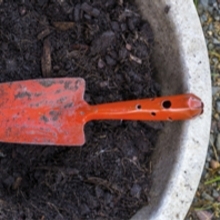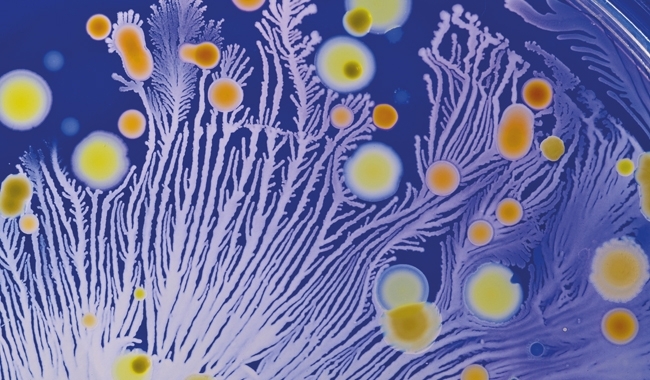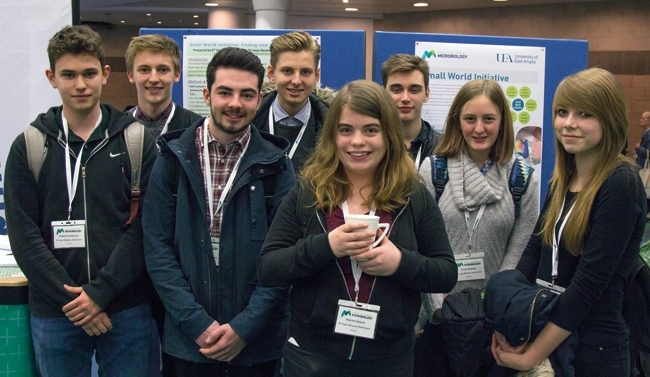Schoolzone & Outreach special: Small World Initiative
07 May 2015

On European Antibiotic Awareness Day, 18 November 2014, we launched the Small World Initiative, giving the general public, students and educators in the UK and Ireland the opportunity to work with scientists as part of a global initiative to discover new antibiotics from soil bacteria.
Why soil?
Most antibiotics in current use have come from soil bacteria, for example, Actinomycetes produce over 60% of clinically important antibiotics. The Initiative, first organised by Yale University, is an innovative research project, which uses crowd-sourcing to discover new antibiotics from soil bacteria. It is now running in higher education institutions across the USA. It is hoped that exposing their undergraduates to research experiences will inspire them to major in a science-based degree. The Society is also expanding the project beyond undergraduate students to include school pupils and the general public in the Initiative so as to engage as many as possible with the topic of soil microbiology and antibiotics, and its wider implications in society.

Why are we running the Small World Initiative?
Antibiotic resistance is an issue of international importance that will impact all of us. The World Health Organization estimates that antibiotic treatments add an average of 20 years to our lives. How we respond to the growing global threat of antimicrobial resistance is one of the most important science questions of our age (see section: Tackling the problem of antimicrobial resistance).
The Small World Initiative’s search for new antibiotics will help engage the public with the problems surrounding drug resistance, drug discovery and the scientific research process. The Initiative will support teachers in providing practical lessons with links to the wider curriculum and give students the opportunity to take part in ‘hands-on’ research that will both encourage them to study science further and to increase the scientific literacy of all of the students involved.
What is the Society doing as part of the Initiative?
The Small World Initiative will have three main areas of work:
BIOLOGY STUDENTS IN THEIR FIRST YEAR OF POST-16 STUDIES (YEAR 12 OR EQUIVALENT)
We have chosen five school partnerships to take part in the Initiative. Each student will collect a soil sample and carry out a series of experiments, looking for novel antimicrobial compounds. The aim is to inspire and motivate students by providing them with the opportunity to take part in a biology-related research project, focusing on the global issue of antimicrobial resistance. It will also be a platform from which to teach a number of key biological concepts and give students the chance to visit a university/workplace partner to do some of the practical work.
UNDERGRADUATE STUDENTS
The aim is to encourage and progress students by allowing them to do real research and take ownership of their science. Each of the 10 universities chosen to take part will use its own expertise so the students can take part in research focused on the global issue of antimicrobial resistance with the scientists who are already working in this area. It will provide them with the vehicle for the investigation of biological and chemical soil ecology and be a platform from which to teach a number of key biological concepts as well as giving all of the students a realistic research experience.
PUBLIC THROUGH CITIZEN SCIENCE PROJECT
Throughout the summer of 2015, the Education and Outreach team will be at various locations around the UK, looking for people to collect a soil sample and follow the research online, where we will be looking for the next new antibiotic! We want to engage the public, through practical activities, with the global issue of antimicrobial resistance and address some of the challenges associated with the discovery of novel antibiotics. The interactive stand will contain information and activities regarding antimicrobial resistance and drug discovery. To find out where we will be and when, please check the website for details.
As part of the Small World Initiative, the Society is collaborating with the University of East Anglia in providing match-funds for a PhD student. With a multi-disciplinary team in microbiology, antibiotic resistance, public engagement and science communication, the student will work as part of the citizen science project, measuring the impact of public engagement in science and analysing the soil samples collected by the public. The Society is really excited to be working with Dr Laura Bowater, Professor Elena Nardi and Dr Gary Rowley, and is looking forward to the great work that this collaboration will produce to advance both microbiology and public engagement with science.
THERESA HUDSON
Education and Outreach Officer
[email protected]
The first school students try out the Small World Initiative |

In the Spring term of this year, 20 budding researchers took on the challenge of being the Small World Initiative’s first participants in the UK. The Sir Isaac Newton Sixth Form College in Norwich teamed up with Dr Laura Bowater from the University of East Anglia to run the programme, which had two students apply for every place available. Each successful student was provided with a sampling kit and a lab book, especially designed and branded for the project. The students collected soil from a variety of local places, including gardens and local parks, and carried out a series of experiments and investigations in the search for novel antimicrobial compounds. Using different media and dilutions of their soil samples, they grew up cultures and all the students identified zones of inhibition on all of their culture plates. At the time of writing, they had begun to investigate whether these may contain potentially unknown antimicrobial compounds. Dr Laura Bowater said of the project: “The Small World Initiative is a fantastic project. I am enjoying the whole process of offering students a research project that genuinely excites and engages them. Also, undertaking the project over several sessions allows the opportunity to follow students on their personal research journey which is an absolute privilege.” The students were equally as enthusiastic, and had the opportunity to present their work at the Society’s Annual Conference in Birmingham. These 20 students are just the first group of many who will be participating in the Small World Initiative School Partnerships. As well as having a great experience doing their research, we hope that one of them will be lucky enough to identify a novel antimicrobial compound. |
Tackling the problem of antimicrobial resistance |
|
The Society’s first President, Alexander Fleming, warned about antimicrobial resistance (AMR) during his 1945 Nobel Prize Speech. However, it is only over the past couple of years that this threat to global health security has hit the mainstream news headlines. AMR now features regularly in the media and, importantly, policy makers and the science, health and agricultural communities, both in the UK and abroad, have begun a concerted effort to tackle this threat. Even the Prime Minister has warned that we could be “cast back into the dark ages of medicine” if nothing is done, when he commissioned an independent review to identify international actions to tackle AMR in July 2014. It is also clear that there is growing concern amongst the public on this issue as over 12,000 people have pledged to be ‘Antibiotic Guardians’ and AMR was voted as the challenge for 2014 Longitude Prize. The UK Government was spurred into action back in 2013 by the Chief Medical Officer, Dame Sally Davies, who warned in a first report that the “catastrophic threat” posed by AMR should be ranked alongside terrorism and climate change as a critical risk to the UK. Later that year the Government published a five-year strategy to tackle AMR through a ‘one health’ approach to promote surveillance, drug and diagnostic development, and antimicrobial stewardship across animal and human health. December 2014 saw high- profile coverage of the first report from the independent review commissioned by the Prime Minster, which provided estimates of the global human and economic costs of inaction. Even just using data from three common forms of resistance, the report estimated that unchecked AMR could cause at least 10 million extra deaths a year, with a cumulative cost to the global economy of up to US$100 trillion by 2050. This makes the nearly US$1.2 billion President Obama has recently proposed to invest in tackling AMR in his 2015 Federal budget proposal look like a good investment. The review’s second report, published in February, recommended initial actions the international community should take, namely investing in the human and economic capital needed to tackle AMR now and in the future. Jim O’Neill, the renowned economist chairing the review, called on “international funders, philanthropic or governmental, to allocate money to a fund that can support blue-sky science and incubate ideas that are more mature” and to invest in the workforce of scientists and health workers needed to fight AMR. Looking forward, new progress should hopefully be made with the UK five-year Action Plan, the World Health Organization is launching an AMR Global Action Plan in May, and the independent review will be recommending market incentives to revitalise the pharmaceutical industry’s investment in the development of sorely needed new antimicrobials and diagnostics. PAUL RICHARDSPolicy Officer |
For more information on the Small World Initiative, visit the website or contact the team on [email protected].
